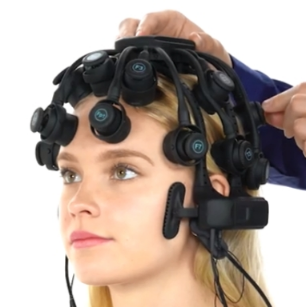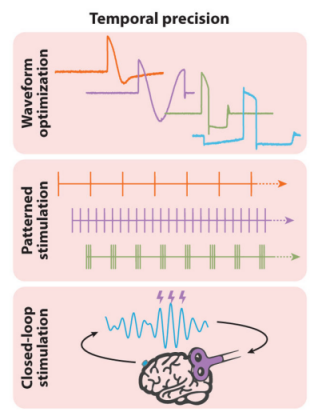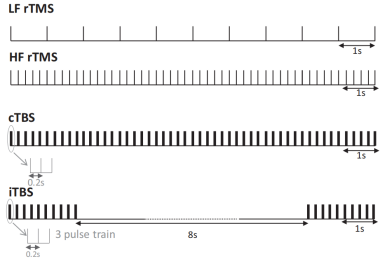Release time :2023-03-13
Source:support@yingchitech.com
Scan:2006

TMS is a non-invasive neuromodulation technology. The time-varying pulsed magnetic field can penetrate the skull non-invasively, act on the central nervous system, generate induced currents, and cause a series of physiological and biochemical reactions, thereby affecting metabolism and neuronal excitability in the brain so that improve and treat mental and neurological diseases.
In general, high-frequency stimulation increases the cortical excitability, whereas low-frequency stimulation has inhibitory control on the neural circuits. High-frequency rTMS (>5 Hz) produces an excitatory effect on neural tissue by inducing a form of long-term potentiation (LTP) that increases efficacy at the synapse that can last beyond the duration of a treatment session. Lowfrequency rTMS (≤1 Hz) produces an inhibitory effect on neural tissue via a long-term depression(LTD)-like mechanism.
Theta burst stimulation (TBS) is a form of TMS that also modulates neural function in a way that reflects LTP-like and LTD-like mechanisms that last longer than those induced by rTMS. TBS uses high-frequency bursts (3 pulses at 50 Hz) that are repeated at intervals of 200 milliseconds. Intermittent TBS (iTBS) increases the amplitude of neuron responses and increases cortical excitability in human motor cortex, whereas a continuous TBS (cTBS) pattern suppresses evoked responses.
Successful pain management with magnetic stimulation may rely on a combination of stimulation types and targets that are tailored to the disease and specific symptoms.[]
TMS device can be used in the treatment and diagnosis of diseases. In disease diagnosis, TMS device is used as a clinical research tool to assess cortical processing time, cortical connectivity function, cortical inhibition, excitability and cortical interactions. In the clinical treatment of diseases, TMS device is mainly used to treat diseases by changing the stimulation frequency to excite or inhibit local cortical functions, respectively, and by bi-directionally regulating the balance between excitatory and inhibitory brain functions. It is mainly used in the treatment of various psychiatric, neurological, neurological rehabilitation and children's brain diseases.
The clinical applications of repetitive transcranial magnetic stimulation in psychiatry are: depression, anxiety, obsessive-compulsive disorder, schizophrenia, bipolar disorder, and post-traumatic stress disorder. Clinical applications in the field of neurology include Parkinson's, Alzheimer's disease, disorders of consciousness, epilepsy, and multiple sclerosis (lower limb spasticity). Clinical applications in the field of rehabilitation mainly include post-stroke dyskinesia, post-stroke aphasia, swallowing disorders, lateral neglect, fibromyalgia, etc. Clinical applications in the field of pediatric rehabilitation mainly include autism, cerebral palsy, attention deficit hyperactivity disorder, tic obscura syndrome, speech delay, etc.
A growing number of studies have shown that brain stimulation devices (TMS) is an effective treatment for neuropsychiatric disorders. However, although TMS has been extensively studied, there is still uncertainty about its therapeutic efficacy. Recently, it has been found that TMS treatment efficacy can be significantly improved by combining electroencephalography (EEG) techniques.

Temporal precision can be achieved by optimizing the waveform of the stimulation[2], employing specific temporal patterns (either mono-frequencies or burst patterns), and by employing closed-loop systems that stimulate during specific phases of neural oscillations.[]Temporal precision can be achieved by optimizing the waveform of the stimulation, employing specific temporal patterns (either mono-frequencies or burst patterns), and by employing closed-loop systems that stimulate during specific phases of neural oscillations.[3]

In 2019, Harvard Hospital published an article stating that patients with first-episode psychiatric disorders have psychiatric disorders associated with abnormal human endogenous neural oscillations. Suggesting multiple connectivity deficits in cortico-cortical and cortico-thalamic modality networks during the initial psychotic episode. []Whereas the degree of endogenous oscillatory resonance and the rhythm of the extrinsic drive are coupled and depend on the amplitude (strength) and frequency of the extrinsic drive, the closer this drive is to the endogenous frequency, the more likely this resonance is to occur, and the stronger the resonance, the stronger the effect of neuroplasticity. In the same year, a UCLA study showed that when treated with rTMS at a stimulation frequency of 10 Hz, depressive symptoms improved more if the patient's alpha peak frequency (IAF) value was closer to 10 Hz, suggesting that setting the rTMS stimulation frequency based on individual neural oscillations may improve depressive symptoms better relative to using a traditional fixed high frequency paradigm.[]

Ying-chi technology offers a wireless dry electrode EEG system that automatically calculates the alpha peak frequency (IAF) and guides the frequency of rTMS treatment with a 3-minute closed-eye resting state EEG.

[1] Young NA, Sharma M, Deogaonkar M. Transcranial magnetic stimulation for chronic pain. Neurosurg Clin N Am. 2014;25(4):819-832. doi:10.1016/j.nec.2014.07.007
[2] Goetz SM, Deng ZD. The development and modelling of devices and paradigms for transcranial magnetic stimulation. Int Rev Psychiatry. 2017;29(2):115-145. doi:10.1080/09540261.2017.1305949
[3] Deng ZD, Luber B, Balderston NL, et al. Device-Based Modulation of Neurocircuits as a Therapeutic for Psychiatric Disorders. Annu Rev Pharmacol Toxicol. 2020;60:591-614. doi:10.1146/annurev-pharmtox-010919-023253
[4] Klomjai W, Katz R, Lackmy-Vallée A. Basic principles of transcranial magnetic stimulation (TMS) and repetitive TMS (rTMS). Ann Phys Rehabil Med. 2015;58(4):208-213. doi:10.1016/j.rehab.2015.05.005
[5] Murphy M, Öngür D. Decreased peak alpha frequency and impaired visual evoked potentials in first episode psychosis. Neuroimage Clin. 2019;22:101693. doi:10.1016/j.nicl.2019.101693
[6] Roelofs CL, Krepel N, Corlier J, et al. Individual alpha frequency proximity associated with repetitive transcranial magnetic stimulation outcome: An independent replication study from the ICON-DB consortium. Clin Neurophysiol. 2021;132(2):643-649. doi:10.1016/j.clinph.2020.10.017